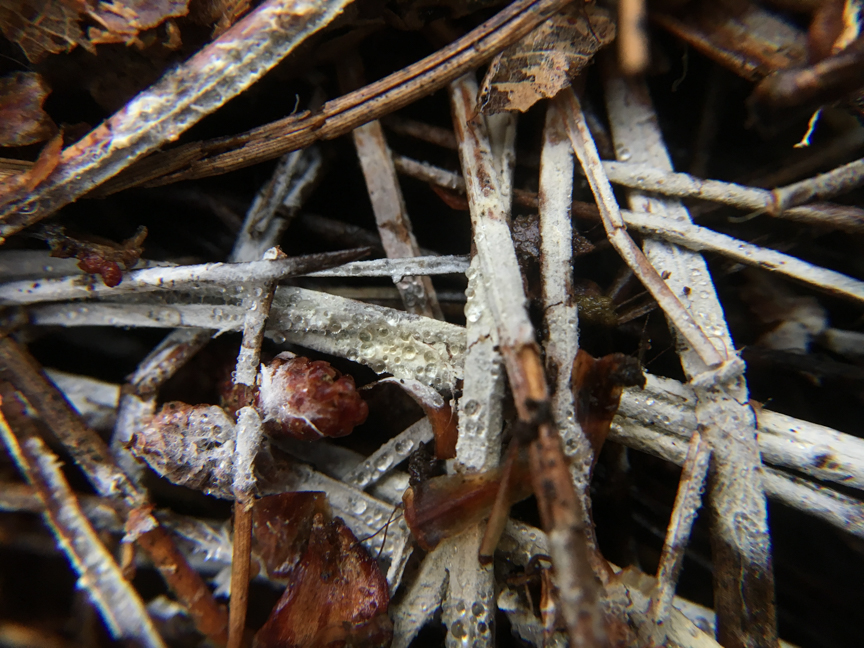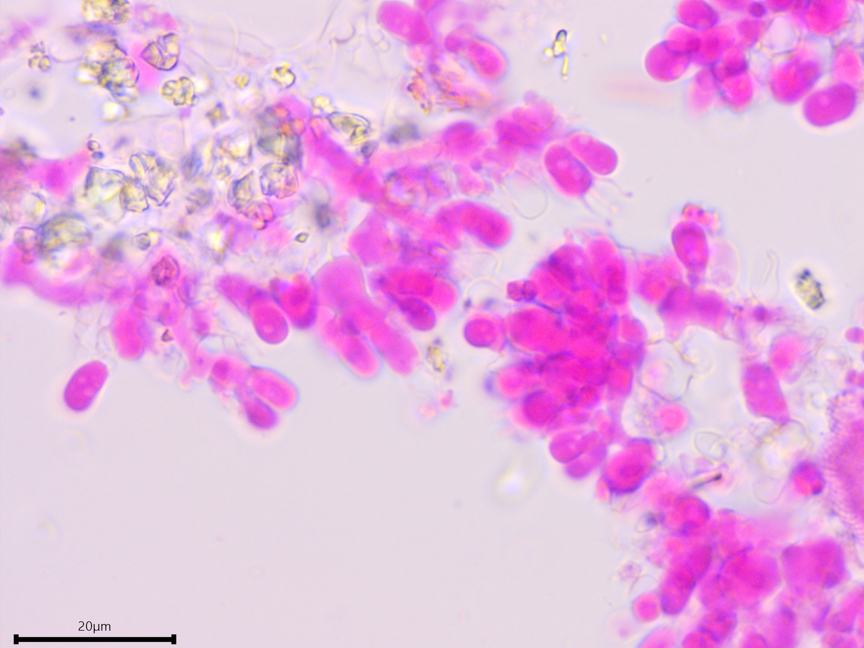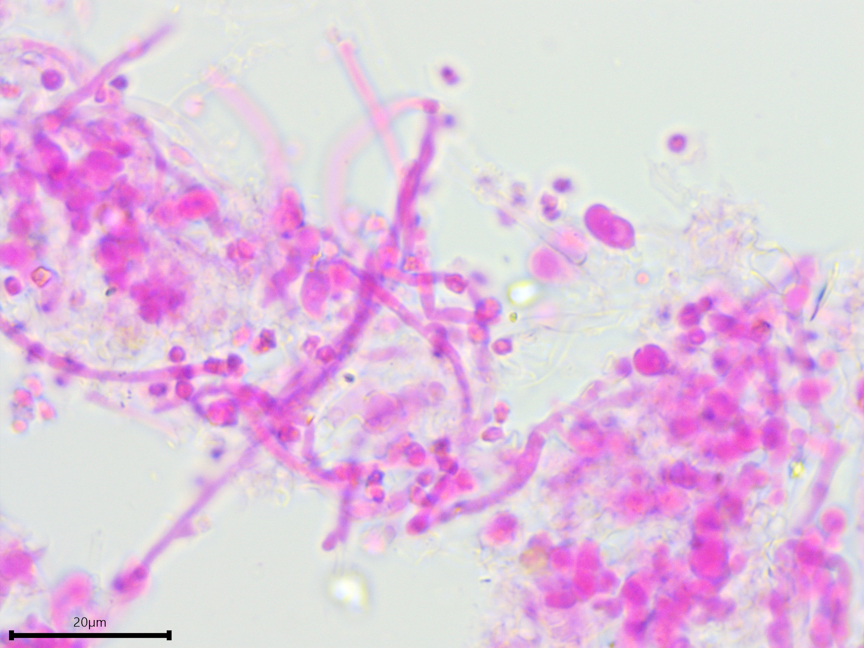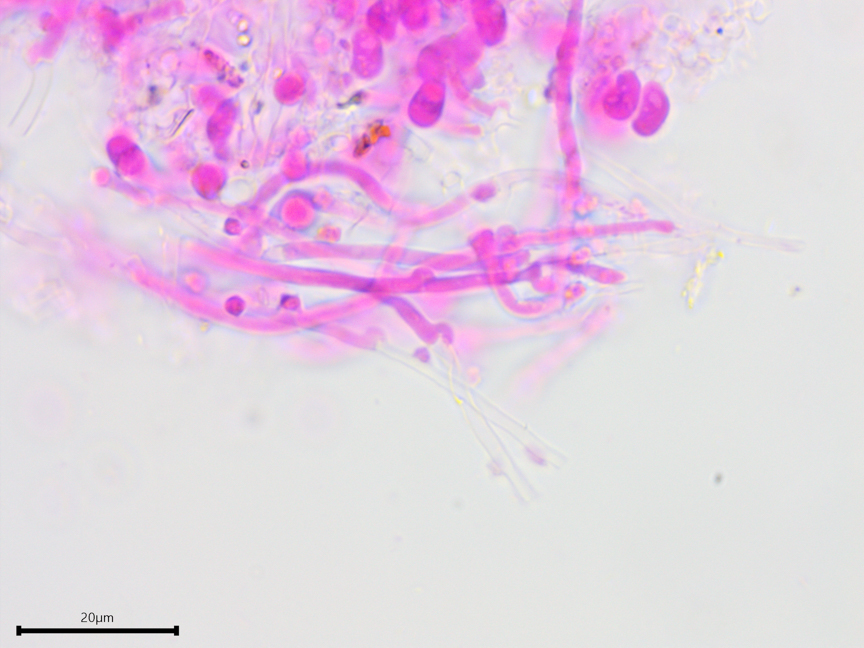Trechispora stellulata (Bourdot & Galzin) Liberta
Introduction
Only in the past twenty years or so, molecular ecology studies have shown that crusts can be major components of ectomycorrhizal communities, particularly in coniferous forests. The importance of this fascinating group of crusts is belied by their simple and overlooked fruiting bodies, which often grow on organic debris even though they are not thought to be consuming it. In a momentous study for the field, Rosenthal et al. (2017) collected crusts across 60 pine and spruce forests in North America and compared DNA sequences from the fruiting bodies to DNA sequences acquired from ectomycorrhizal root tips. Based on high DNA sequence similarity between these samples, they confirmed that Trechispora stellulata is indeed ectomycorrhizal.
From a morphological standpoint, Trechispora crusts have fragile basidiomata, short basidia, and ampullate hyphae (Liberta 1966). The small, ornamented spores of Trechispora stellulata remind me of little sunchokes and are a defining characteristic for this species.
Description
Ecology: Ectomycorrhizal with Pinaceae trees (Rosenthal et al. 2017), widespread across the temperate Northern Hemisphere. The documented specimen was found on the underside of pine duff.
Basidioma: Thin, effused, smooth hymenophore, arachnoid to byssoid in texture, whitish, producing guttation droplets, with a fimbriate margin, occassionally rhizomorphic, fusing the duff together.
Chemical reactions: NA
Spore print: NA
Hyphal system: Monomitic with clamps at all septa, occasionally ampulate, globular to angular encrustations occassional; width 1.8–2.7 µm (n = 10 hyphae).
Basidia: Short and cylindrical, terminal, with four sterigmata and a basal clamp; length (7.4) 7.4–9.2 (10.1) µm, width (3.7) 4.2–5.0 (5.1) µm, x̄ = 8.3 ✕ 4.6 µm, Q (1.5) 1.6–2 (2.1), x̄ = 1.8 (n = 10 basidia).
Basidiospores: Ellipsoid, ornamented, reminiscent of Jerusalem artichokes (obtuse spines), inamyloid; length (2.8) 3.0–3.6 (3.8) µm, width (1.7) 1.9–2.6 (3.3) µm, x̄ = 3.3 ✕ 2.2 µm, Q (1.1) 1.3–1.7 (1.9), x̄ = 1.5 (n = 30 basidiospores).
Sterile structures: Absent.
Sequences: NA
Notes: All measurements taken in 5% KOH stained with phloxine.
Specimens Analyzed
ACD0203, iNat33962903; 04 October 2019; Middleville, Barry Co., MI, USA, 42.6389 -85.4530; leg. & det. Alden C. Dirks, ref. Bernicchia & Gorjón (2010); University of Michigan Fungarium MICH 352202.
References
Liberta, A. E. (1966). On Trechispora. Taxon, 15(8), 317–319.
Rosenthal, L. M., Larsson, K.-H., Branco, S., Chung, J. A., Glassman, S. I., Liao, H.-L., … Bruns, T. D. (2017). Survey of corticioid fungi in North American pinaceous forests reveals hyperdiversity, underpopulated sequence databases, and species that are potentially ectomycorrhizal. Mycologia, 109(1), 115–127.
Links

When a crust is growing on the bottom of leaf debris like this, it is a pretty good indicator that it might be ectomycorrhizal.

Trechispora stellulata basidioma and hymenophore, with guttation.

A few deciduous leaves were present; the crust grew on both.

Short, cylindrical basidia with four stergimata and hyphae with encrustations.

Basidia and ornamented basidiospores.

Ornamented basidiospores.

Clamp connections.
